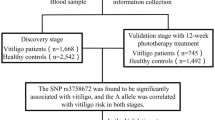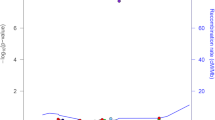Abstract
Vitiligo is an acquired pigmentary disorder with several proposed pathogenesis mechanisms and complex multifactorial genetic predisposition. We analyzed 65 polymorphisms in genes potentially relevant to vitiligo pathogenesis mechanism to reveal novel and confirm reported genetic risk factors in general Russian population. We found that polymorphism rs1138272 (TC + CC) in GSTP1 gene encoding enzyme involved in xenobiotic metabolism is associated with vitiligo (Bonferroni adjusted P value 0.0015) with extraordinary high odds ratio 13.03, and haplotype analysis confirmed association of GSTP1 gene with vitiligo risk. Moreover, analysis of variations in several genes encoding enzymes of xenobiotic metabolism showed that higher risk of vitiligo is associated with higher number of risk alleles. This finding reveals possible contribution of genetic background to observed imbalance of oxidative stress control in vitiligo through cumulative effect of multiple genetic variations in xenobiotic metabolizing genes, supporting the concept of multigenic nature of vitiligo with multiple low-risk alleles cumulatively contributing to vitiligo risk.

Similar content being viewed by others
References
Abramson JH (2011) WINPEPI updated: computer programs for epidemiologists, and their teaching potential. Epidemiol Perspect Innov 8(1):1
Akey J, Jin L, Xiong M (2001) Haplotypes vs single marker linkage disequilibrium tests: what do we gain? Eur J Hum Genet 9(4):291–300
Alikhan A, Felsten LM, Daly M, Petronic-Rosic V (2011) Vitiligo: a comprehensive overview Part I. Introduction, epidemiology, quality of life, diagnosis, differential diagnosis, associations, histopathology, etiology, and work-up. J Am Acad Dermatol 65(3):473–491
Alkhateeb A, Fain PR, Thody A, Bennett DC, Spritz RA (2003) Epidemiology of vitiligo and associated autoimmune diseases in Caucasian probands and their families. Pigment Cell Res 16(3):208–214
Bassiouny DA, Khorshied MM (2012) Glutathione S-transferase M1 and T1 genetic polymorphism in Egyptian patients with nonsegmental vitiligo. Clin Exp Dermatol doi:10.1111/j.1365-2230.2012.04413.x
Birlea SA, Jin Y, Bennett DC, Herbstman DM, Wallace MR, McCormack WT, Kemp EH, Gawkrodger DJ, Weetman AP, Picardo M, Leone G, Taïeb A, Jouary T, Ezzedine K, van Geel N, Lambert J, Overbeck A, Fain PR, Spritz RA (2011) Comprehensive association analysis of candidate genes for generalized vitiligo supports XBP1, FOXP3, and TSLP. J Invest Dermatol 131(2):371–381
Birlea SA, Gowan K, Fain PR, Spritz RA (2010) Genome-wide association study of generalized vitiligo in an isolated European founder population identifies SMOC2, in close proximity to IDDM8. J Invest Dermatol 130(3):798–803
Ekhart C, Doodeman VD, Rodenhuis S, Smits PH, Beijnen JH, Huitema AD (2009) Polymorphisms of drug-metabolizing enzymes (GST, CYP2B6 and CYP3A) affect the pharmacokinetics of thiotepa and tepa. Br J Clin Pharmacol 67(1):50–60
Guan CP, Zhou MN, Xu AE, Kang KF, Liu JF, Wei XD, Li YW, Zhao DK, Hong WS (2008) The susceptibility to vitiligo is associated with NF-E2-related factor2 (Nrf2) gene polymorphisms: a study on Chinese Han population. Exp Dermatol 17(12):1059–1062
Jin Y, Birlea SA, Fain PR, Gowan K, Riccardi SL, Holland PJ, Mailloux CM, Sufit AJ, Hutton SM, Amadi-Myers A, Bennett DC, Wallace MR, McCormack WT, Kemp EH, Gawkrodger DJ, Weetman AP, Picardo M, Leone G, Taïeb A, Jouary T, Ezzedine K, van Geel N, Lambert J, Overbeck A, Spritz RA (2010) Variant of TYR and autoimmunity susceptibility loci in generalized vitiligo. N Engl J Med 362(18):1686–1697
Jin Y, Birlea SA, Fain PR, Mailloux CM, Riccardi SL, Gowan K, Holland PJ, Bennett DC, Wallace MR, McCormack WT, Kemp EH, Gawkrodger DJ, Weetman AP, Picardo M, Leone G, Taïeb A, Jouary T, Ezzedine K, van Geel N, Lambert J, Overbeck A, Spritz RA (2010) Common variants in FOXP1 are associated with generalized vitiligo. Nat Genet 42(7):576–578
Kaplan N, Morris R (2001) Prospects for association-based fine mapping of a susceptibility gene for a complex disease. Theor Popul Biol 60(3):181–191
Kostyuk VA, Potapovich AI, Cesareo E, Brescia S, Guerra L, Valacchi G, Pecorelli A, Deeva IB, Raskovic D, De Luca C, Pastore S, Korkina LG (2010) Dysfunction of glutathione S-transferase leads to excess 4-hydroxy-2-nonenal and H(2)O(2) and impaired cytokine pattern in cultured keratinocytes and blood of vitiligo patients. Antioxid Redox Signal 13(5):607–620
Li D, Dandara C, Parker MI (2010) The 341C/T polymorphism in the GSTP1 gene is associated with increased risk of oesophageal cancer. BMC Genet 11:47
Li K, Li C, Gao L, Yang L, Li M, Liu L, Zhang Z, Liu Y, Gao T (2009) A functional single-nucleotide polymorphism in the catechol-O-methyltransferase gene alter vitiligo risk in a Chinese population. Arch Dermatol Res 301(9):681–687
Liu L, Li C, Gao J, Li K, Gao L, Gao T (2009) Genetic polymorphisms of glutathione S-transferase and risk of vitiligo in the Chinese population. J Invest Dermatol 129(11):2646–2652
Liu N, Zhang K, Zhao H (2008) Haplotype-association analysis. Adv Genet 60:335–405
Morris RW, Kaplan NL (2002) On the advantage of haplotype analysis in the presence of multiple disease susceptibility alleles. Genet Epidemiol 23(3):221–233
Moyer AM, Salavaggione OE, Wu TY, Moon I, Eckloff BW, Hildebrandt MA, Schaid DJ, Wieben ED, Weinshilboum RM (2008) Glutathione S-transferase p1: gene sequence variation and functional genomic studies. Cancer Res 68(12):4791–4801
Natarajan VT, Singh A, Kumar AA, Sharma P, Kar HK, Marrot L, Meunier JR, Natarajan K, Rani R, Gokhale RS (2010) Transcriptional upregulation of Nrf2-dependent phase II detoxification genes in the involved epidermis of vitiligo vulgaris. J Invest Dermatol 130(12):2781–2789
Quan C, Ren YQ, Xiang LH, Sun LD, Xu AE, Gao XH, Chen HD, Pu XM, Wu RN, Liang CZ, Li JB, Gao TW, Zhang JZ, Wang XL, Wang J, Yang RY, Liang L, Yu JB, Zuo XB, Zhang SQ, Zhang SM, Chen G, Zheng XD, Li P, Zhu J, Li YW, Wei XD, Hong WS, Ye Y, Zhang Y, Wu WS, Cheng H, Dong PL, Hu DY, Li Y, Li M, Zhang X, Tang HY, Tang XF, Xu SX, He SM, Lv YM, Shen M, Jiang HQ, Wang Y, Li K, Kang XJ, Liu YQ, Sun L, Liu ZF, Xie SQ, Zhu CY, Xu Q, Gao JP, Hu WL, Ni C, Pan TM, Li Y, Yao S, He CF, Liu YS, Yu ZY, Yin XY, Zhang FY, Yang S, Zhou Y, Zhang XJ (2010) Genome-wide association study for vitiligo identifies susceptibility loci at 6q27 and the MHC. Nat Genet 42(7):614–618
Sole X, Guino E, Valls J, Iniesta R, Moreno V (2006) SNPStats: a web tool for the analysis of association studies. Bioinformatics 22(15):1928–1929
Spritz RA (2011) The genetics of vitiligo. J Invest Dermatol 131(E1):E18–E20
Spritz RA (2011) Recent progress in the genetics of generalized vitiligo. J Genet Genomics 38(7):271–278
Spritz RA (2010) The genetics of generalized vitiligo: autoimmune pathways and an inverse relationship with malignant melanoma. Genome Med 2(10):78
Stuttgen G (1950) Hereditary aspects of vitiligo. Z Haut Geschlechtskr 9(11):451–457
Teindel H (1950) Familial vitiligo. Z Haut Geschlechtskr 9(11):457–462
Uhm YK, Yoon SH, Kang IJ, Chung JH, Yim SV, Lee MH (2007) Association of glutathione S-transferase gene polymorphisms (GSTM1 and GSTT1) of vitiligo in Korean population. Life Sci 81(3):223–227
Xu X, Chen J (2009) One-carbon metabolism and breast cancer: an epidemiological perspective. J Genet Genomics 36(4):203–214
Acknowledgments
Authors are grateful to Ekaterina A. Bessonova for excellent technical assistance. The work was supported by the Vitiligo Research Foundation (VR Foundation).
Conflict of interest
The authors declare no conflict of interest.
Author information
Authors and Affiliations
Corresponding author
Additional information
M. M. Minashkin and L. E. Salnikova contributed equally to this work.
Electronic supplementary material
Below is the link to the electronic supplementary material.
Rights and permissions
About this article
Cite this article
Minashkin, M.M., Salnikova, L.E., Lomonosov, K.M. et al. Possible contribution of GSTP1 and other xenobiotic metabolizing genes to vitiligo susceptibility. Arch Dermatol Res 305, 233–239 (2013). https://doi.org/10.1007/s00403-012-1301-x
Received:
Revised:
Accepted:
Published:
Issue Date:
DOI: https://doi.org/10.1007/s00403-012-1301-x




